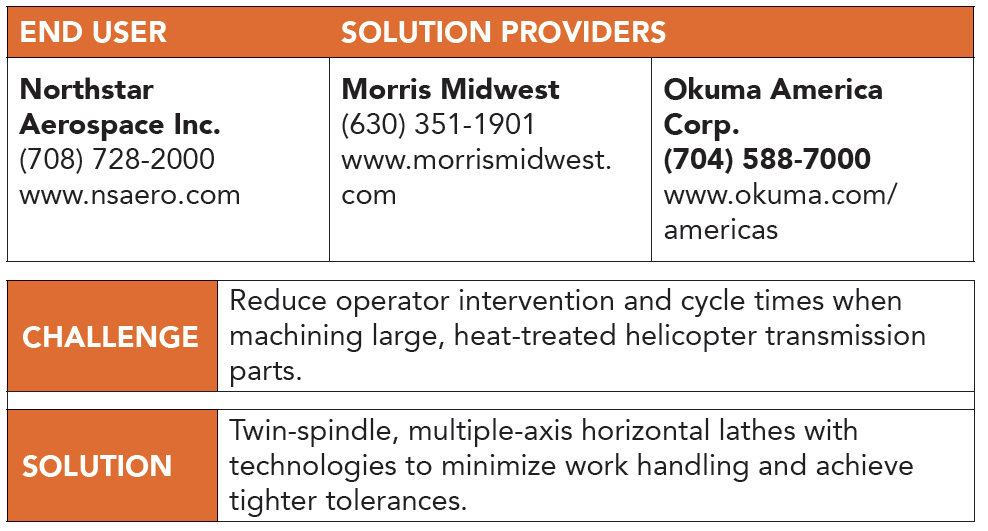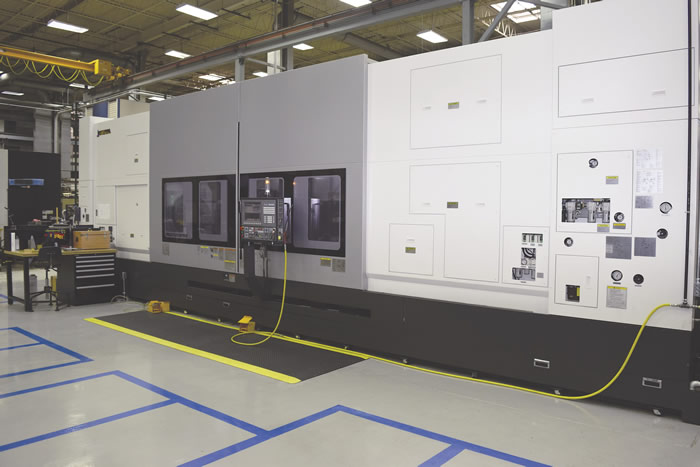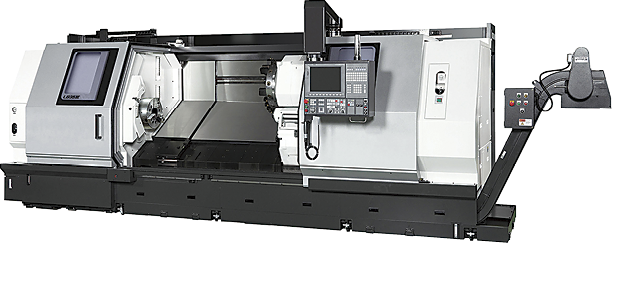 Multiple machine tool builders offer equipment for machining the helicopter transmission components Northstar Aerospace Inc. produces at its Bedford Park, Ill., facility, but not all are equally efficient in handling the task.
Multiple machine tool builders offer equipment for machining the helicopter transmission components Northstar Aerospace Inc. produces at its Bedford Park, Ill., facility, but not all are equally efficient in handling the task.
The parts weigh up to 350 lbs. (159 kg), have diameter tolerances as tight as 0.0003" (0.0076mm) and are made of aerospace-grade superalloys typically hardened from 50 to 60 HRC, said Brian Cheek, vice president and general manager at Northstar.
The company needed to increase efficiencies to meet its hectic production schedule and examined some replacement offerings comparable to two of Northstar’s lathes. The search led to Northstar purchasing a new Okuma MULTUS B750 horizontal lathe and an LB35III horizontal lathe from Okuma distributor Morris Midwest’s Roselle, Ill., location. (Okuma America Corp. is headquartered in Charlotte, N.C.)
In addition to the “very attractive offer to bundle the two machines together,” Cheek said the Okuma machines are more rigid than the previous machines, in part because of their heavily ribbed bed and base casting and the Okuma “thermal-friendly” design. “Having more rigidity certainly helps with the tight tolerances we must hold for the aerospace industry,” he said, adding that the enhanced rigidity enables Northstar to take heavier DOCs, including interrupted cuts, and reduce cycle times compared to its previous machines.
Cheek added that Northstar was able to quickly accept delivery because the machines were readily available from Morris Midwest, while others offered lead times in excess of a year. Nonetheless, shipping and installing a machine tool as massive as the MULTUS B750 required four 18 wheelers and a team of skilled technicians. The machine has a large work envelope, a 41" (1,041.4mm) turning diameter and a 160" (4,064mm) turning length with a subspindle. (To view a video of the 4-week installation process in a little more than 3 minutes, visit youtube.com and enter “Northstar Okuma” into the search field.)
Along with the machines, the purchase package included operator training at the Okuma Aerospace Center of Excellence, Charlotte. “The feedback from the operators was that they were very pleased with the training,” Cheek said.
The technologies of the MULTUS B750 limits operator intervention and work handling. Previously, operators had to remove a component from a machine and flip it to machine the opposite side, but, with the twin-spindle capability of the new 6-axis horizontal lathe, the work can be transferred from the first spindle to the second one automatically. Cheek added that theNorthstar improved part handling by 50 percent and overall operation efficiency by 30 percent.


Northstar Aerospace produces helicopter transmission parts hardened up to 60 HRC on its Okuma MULTUS B750 horizontal lathe. Image courtesy Northstar Aerospace.

To overcome issues Northstar was experiencing with part distortion on its previous machines, the company worked closely with Okuma and Morris application engineers to fine-tune the cutting processes. Northstar discovered by changing the order a part is cut, it could minimize distortion.
In addition, Northstar overcame the machine crashes it was struggling with on the previous machines. “Any time that happens, getting parts for the machine becomes an issue and creates downtime,” Cheek said. Okuma’s Collision Avoidance Software (CAS) comes standard on the MULTUS. According to Okuma, the software aids in increasing shop floor efficiencies by integrating 3D modeling of Okuma machines, tooling and part blanks with the machine tool builder’s OSP-P control. This creates a virtual machine that runs real-time virtual applications to detect cutting problems and prevent costly crashes.
Cheek added that Northstar uses Esprit CAD/CAM programming software from DP Technology Corp. to complement CAS by enhancing 3D modeling and avoiding any type of machine crash.


Besides the MULTUS B750, Northstar purchased an Okuma LB35III single-saddle horizontal lathe. Image courtesy Okuma America.

In addition to the CAD/CAM software, the setup on the B750 also includes other efficiency-improving technologies from Partners in THINC (a collaboration among Okuma and suppliers of cutting tools, software, workholders and other manufacturing equipment). These include: a probe from Renishaw Inc. for in-process gaging, which allows the machine to check the part itself without operator intervention; a high-pressure coolant system from MP Systems Inc., which enhances coolant flow to the cutting tool and helps extend tool life; and Tool Monitor Adaptive Control from Caron Engineering Inc., which monitors electric current load to the spindle and stops the machine if the load exceeds its established value. TMAC also has an adaptive feature that increases or decreases cutting feed rates if a load is within a safe cutting range. Northstar also turned to Sandvik Coromant Co. for toolholders and inserts.
“The partnerships between those companies, as well as Northstar, has improved the overall process and achieved efficiencies to support the troops,” Cheek said.
Related Glossary Terms
- coolant
coolant
Fluid that reduces temperature buildup at the tool/workpiece interface during machining. Normally takes the form of a liquid such as soluble or chemical mixtures (semisynthetic, synthetic) but can be pressurized air or other gas. Because of water’s ability to absorb great quantities of heat, it is widely used as a coolant and vehicle for various cutting compounds, with the water-to-compound ratio varying with the machining task. See cutting fluid; semisynthetic cutting fluid; soluble-oil cutting fluid; synthetic cutting fluid.
- feed
feed
Rate of change of position of the tool as a whole, relative to the workpiece while cutting.
- in-process gaging ( in-process inspection)
in-process gaging ( in-process inspection)
Quality-control approach that monitors work in progress, rather than inspecting parts after the run has been completed. May be done manually on a spot-check basis but often involves automatic sensors that provide 100 percent inspection.
- lathe
lathe
Turning machine capable of sawing, milling, grinding, gear-cutting, drilling, reaming, boring, threading, facing, chamfering, grooving, knurling, spinning, parting, necking, taper-cutting, and cam- and eccentric-cutting, as well as step- and straight-turning. Comes in a variety of forms, ranging from manual to semiautomatic to fully automatic, with major types being engine lathes, turning and contouring lathes, turret lathes and numerical-control lathes. The engine lathe consists of a headstock and spindle, tailstock, bed, carriage (complete with apron) and cross slides. Features include gear- (speed) and feed-selector levers, toolpost, compound rest, lead screw and reversing lead screw, threading dial and rapid-traverse lever. Special lathe types include through-the-spindle, camshaft and crankshaft, brake drum and rotor, spinning and gun-barrel machines. Toolroom and bench lathes are used for precision work; the former for tool-and-die work and similar tasks, the latter for small workpieces (instruments, watches), normally without a power feed. Models are typically designated according to their “swing,” or the largest-diameter workpiece that can be rotated; bed length, or the distance between centers; and horsepower generated. See turning machine.
- superalloys
superalloys
Tough, difficult-to-machine alloys; includes Hastelloy, Inconel and Monel. Many are nickel-base metals.
- turning
turning
Workpiece is held in a chuck, mounted on a face plate or secured between centers and rotated while a cutting tool, normally a single-point tool, is fed into it along its periphery or across its end or face. Takes the form of straight turning (cutting along the periphery of the workpiece); taper turning (creating a taper); step turning (turning different-size diameters on the same work); chamfering (beveling an edge or shoulder); facing (cutting on an end); turning threads (usually external but can be internal); roughing (high-volume metal removal); and finishing (final light cuts). Performed on lathes, turning centers, chucking machines, automatic screw machines and similar machines.
- work envelope
work envelope
Cube, sphere, cylinder or other physical space within which the cutting tool is capable of reaching.
